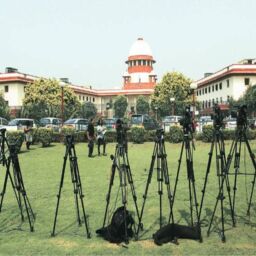INTRODUCTION
In 2020, due to the COVID-19 pandemic, there was a lockdown all over the nation where the usage of drones has increased for purposes like videography, surveillance, and disinfection. So, the draft Unmanned Aircraft System (UAS) Rules, 2020 was notified by the Ministry of Civil Aviation (MoCA). Previously, drone regulations 1.0 and drone regulations 2.0 were issued by the government.[1] Also, to handle the threats from Unmanned Aircraft Systems, the government has finalized National Counter Rogue Drone Guidelines. Whereas based on “trust, self-certification, and non-intrusive monitoring”, the Draft Drone Rules, 2021 were disclosed by the MoCA. The existing Unmanned Aircraft System (UAS) Rules will be replaced by the new rules. These new rules focus on giving importance to the new technology and its usage on the ground. By the next 8-10 years it is expected that the cumulative market potential for the drone sector to be increased as much as Rs.3 crore. These rules benefit the companies and individuals to operate and manage drones. For shareholders and manufacturers, it makes the certification process simpler.
CLASSIFICATION OF DRONES
Based upon the maximum all-up weight including payload, the drones can be classified as mentioned below:[2]
- If the drone is greater than or equal to 250 grams then it is a ‘Nano drone’;
- If the drone is greater than 250 grams and less than or equal to 2 kilograms then it is a ‘Micro drone’;
- If the drone is greater than 2 kilograms and less than or equal to 25 kilograms then it is a ‘Small drone’;
- If the drone is greater than 25 kilograms and less than or equal to 150 kilograms then its a ‘Medium drone’;
- If the drone is greater than 150 kilograms then it is a ‘Large drone’.
DRAFT DRONE RULES, 2021
- A unique identification number has been specified to each drone with the transmission of their altitude, speed, location, etc. in case if any drone misses the unique identification number with the other details, then it will be considered as a rogue drone. In the digital sky platform, every flight of the drone will be monitored. In case if any remote pilot tries to fly a drone, then its flight path will be registered in the platform automatically.
- The Indian government will develop a digital sky platform where it will have an interactive airspace map that develops the country into red, green, and yellow zones. It provides a secure and scalable platform where it supports drone technology frameworks.
- The airport perimeter got reduced by the draft rules from 45km to 12km. According to the rules, to fly up to 400 feet in the green zones and up to 200 feet in the area below 8-12 km from the airport perimeter, no flight permissions are required.[3]
- For micro-drones which are used for non-commercial purposes, nano drones and the organisation of Research and Development, there is no need for a pilot licence. The foreign owned companies will not be restricted on drone operations in case if there are registered in India.
- To ensure a business-friendly regulatory regime, a drone promotion council will be established. For cargo deliveries, the development of drone corridors will be arranged by the Ministry.
- The draft rule provides safety measures likes geofencing and real-time tracking beacon where these are expected to be notified in the future. For compliance, a six-month lead time will be given.[4]
- The coverage of drones has been increased from 300kg to 500kg besides covering drone taxis. The Quality Council of India has been delegated to the issuance of Certificate of Airworthiness and the Certification authorities are authorized by it.
- The requirement to grant permission for the acquisition and usage of drones have been simplified. In order to get prototypes, the requirements for the stakeholders and the manufactures have been made easier.
- The industries have been provided with the ‘Ease of doing businesses. Previously there was 25 form to fill up which got reduced to 5. Clarification on registration and remote-pilot licencing was provided. Drones Insurance has been taken into consideration.[5]
PROBLEMS INVOLVED[6]
- Operating the drones without any legal backing can cause security threats. There are also incidents like arms being dropped by the drones (for example the recent Jammu drone attack).
- According to the new draft, the rules are not applicable to the air force, the army or the navy. But still, paramilitary forces are included. Due to the drones coming across the lines, the Border Security Force (BSF) is getting suffered a lot.
- Compared to conventional weapons, drones are cheaper. The main reason for the increase in drone attacks is that they have more destructive results.
RESTRICTIONS TO FLY A DRONE IN INDIA[7]
- In the case of Nano drones, they shall not fly this category drones beyond 60 meters of height above ground level (AGL) or at a maximum speed of 25 meters per second.
- In the case of Small drones, they shall not fly this category drones beyond 120 meters of height above ground level (AGL) or at a maximum speed of 25 meters per second.
- In the case of Medium or Large drones, the drones shall fly according to the conditions to the conditions which are specified under the Operator Permit that is issued by the DGCA.
- To fly a drone over the restricted areas there should be prior permission required from the DGCA.
PENALITIES FOR FLYING DRONES ILLEGALLY IN INDIA[8]
In case if any individual operates a drone (exceptional to Nano drones) without a valid licence or permit shall pay a fine of Rs.25,000. In case if they fly a drone over the no-operation zones then they have to pay a fine of Rs.50,000. In case they are flying a drone without valid third-party insurance then they have to pay a fine of Rs.10,000.
CONCLUSION
Even after the recent Jammu drone attack, the government of India liberalized the drone policy in India. This approach of the government is to promote the usage of drones and to focus on the counter-drone technology development in order to address the threat posed by the rogue drones. This new draft facilities investments in drone technology in India in a long way. The security concern should deal judicially and they are not just allowed to restrict anyone from adopting the drone technology. In future, it is expected that drone technology will be the most cost-effective choice, and in the domains of military and civilians, it will become the most utilised system.
Author(s) Name: Jetti Vaishnavi (Student, Damodaram Sanjivayya National Law University, Visakhapatnam)
References:
[1] ‘Draft Unmanned Aircraft System (UAS) Rules, 2020’, (drishti, 28th July, 2021) https://www.drishtiias.com/daily-updates/daily-news-analysis/draft-unmanned-aircraft-system-uas-rules-2020
[2] The Drone Rules, 2021
[3] ‘Draft Drone Rules, 2021’, (drishti, 28th July, 2021) https://www.drishtiias.com/daily-updates/daily-news-analysis/draft-drone-rules-2021
[4] ibid
[5] ‘The Big Picture: Draft Drone Rules: Impetus to Future Tech’, (drishti, 29th July, 2021) https://www.drishtiias.com/loksabha-rajyasabha-discussions/the-big-picture-draft-drone-rules-impetus-to-future-tech
[6] ibid
[7] ‘Flying a drone in India? See what 2021 drones rules say for pilots’, (geoawesomeness, 29th July, 2021) https://geoawesomeness.com/drone-flying-india-2021-rules-pilots/
[8] ibid
















